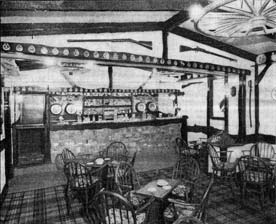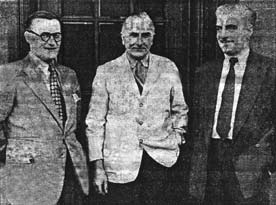Redcliffe Drive, East Kilbridge, G75 8YQ.
The Westwood Bar.

Westwood Bar Advert 1970.

A 1974 advert.
Redcliffe Drive, East Kilbridge, G75 8YQ.

The Westwood Bar.

Westwood Bar Advert 1970.

A 1974 advert.
1 Montgomerie Street, East Kilbride. Telephone 01355 220833.

Montgomerie Arms.

Montgomerie Arms. 2006
The Montgomerie Arms Hotel, East Kilbride, which was bought by Mr Mitchell Haxton in 1953, is one of the original coaching inns, dating back to 1656.
The hotel was better known locally as the “Held Inns” from the arms of Earl of Eglinton on the inn sign. In front of the hotel can still be seen the “loupin stane”, reminiscent of the days when farmers came to market with their wives riding pillon.
Mr Haxton added to the amenities of the old hotel by converting part of the premises to cope with the present day demands. He had laid out a cocktail bar and three lounges, in what was formerly the stable, harness-room, bothy and parlour, without detracting from its old-world atmosphere.

Mr Mitchell Haxton. 1957.
It had taken three years, almost single-handed to complete the work. Much of the original stone work had been retained by the owner, an enthusiastic craftsman, who was his own stonemason, cabinetmaker, joiner and black-smith. Other stone was brought from a local quarry.
Old carriage lamps, with electric bulbs, had been retained to provide part of the lighting, supplemented by candle-shaped lights mounted on carriage wheels attached to the ceilings in each room. The cocktail bar was of simple design, with antique furniture forming the gantry in front of the bare original masonry of the old stable.
Brickwork under the bar top- a large piece of polished bark- was in keeping with the layout and Cornish tiles had been used on the floor fronting the bar. Horse brasses were used extensively for decorations and tartan fitted carpets covered the floors. Old firearms, swords, horns, etc, were placed at intervals round the walls, together with old crockery. Tables and chairs were also in keeping with the old-world theme.

The new bar of the converted premises. 1957.
Between two lounges stands an open fireplace, reconstructed by Mr Haxton, to provide heat from either side. Behind the bar was the beer and wine cellars. Here as in the public bar, beer was pumped through imitation barrels fitted into the walls of the gantries. This work and the electrical installation was also carried out by Mr Haxton. Only the modern toilets, leading from the cocktail lounge and the plaster-work were contracted out.

The old stables, with horse-boxes, stood here; now its the new cocktail Bar. 1957.
Windows were replaced with glass bricks. In the public bar barrels were used for tables, each having a polished top. At either end was an open fireplace. The bar itself was L shaped and the roof raftered. Lantern-type lamps provided the illumination.
The hotel had four letting bedrooms and had an inn and hotel licence for a six-day week. The upper floor, Mr Haxton had converted the premises into living accommodation on a modern scale with up-to-date kitchen, lounge, bedroom and bathroom. There was ample room for extension at the rear of the building, and Mr Haxton had plans in hand for a new dining room and an extension of his cellar accommodation.

The old Bothy is now a lounge adjoining the bar. 1957.
Several tons of earth had to be removed by the owner when he reduced the floor level of the old bothy and stables to bring them to the level of the other parts of the premises.
The newly-converted premises were opened officially by Mr D Pollock Smith, J.P., D.l. of Lanarkshire in January 1957.

Left to right. James Lundie,Cavendish Bar, Ernest Pyatt, Bowhill Hotel, Fife, Mr Mitchell Haxton of the Star Bar, Eglinton Street. 1950.
Mr John Haxton senior was listed as a Spirit Salesman in 1901. He had five children, his oldest son also John, inherited the pubs when his father died. Mitchell the middle son also became a publican in Glasgow, East Kilbride and Majorca.
Thanks to Karin Newton.
In 1927 John Haxton was licensee of the Star Bar, 537 Eglinton Street, Glasgow. Ten years later he was running another pub at 30 Glassford Street in the city centre of Glasgow. In 1937 his son John was licensee for premises at 722 Pollokshaws Road now the Allison Arms bar.
John Haxton sen., was living at Brookville, Sandhills Road, Mount Vernon in 1937, while his son was living at 23 Radnor Street.
In 1947 John had moved house to 33 Tassie Street, Shawlands. His brother Mitchell lived at 65 Tassie, Street, while Mary Kemp Haxton who was licensee at 30 Glassford Street was living at Sandhills Road.
See other images of Mr Haxton. Click here. Also see the Rosshire Bar.
————————————–
In the NEWS 1978…
Popular Pub- They Queue Up To Get In…

Exterior view of the Montgomerie Arms 1978.
One of the most popular pubs in Scotland, that is the Montgomerie Arms in East Kilbride. People come from all over the world to visit the old tavern.
On Fridays and Saturdays customers can wait outside for up to an hour to get in. “I really don’t know why this shop is so popular,” said the owner Robert Meiklem.
“Perhaps it’s something to do with the atmosphere and the decor, or perhaps it’s because they get good service and good beer.”
On a Friday and Saturday evening there are around 500 people in the Montgomerie Arms with a queue outside waiting to get in.
MONUMENT
The pub is just not big enough to cope with the demand, although it consists of a public bar and two lounge bars. The Montgomerie Arms dates back to 1655, when it opened as a coaching Inn now it is a grade A historical monument.
From outside its olde world appearance has been preserved, while the interior is decorated in the Tudor style, with roaring coal fires.
The upstairs lounge, however, is decorated in an up-to-the-minute Spanish style setting. The Montgomerie Arms is a free house, and it carries one of the best stocks of beer and spirit in the land.

Customers enjoying a pint at the Montgomerie Arms 1978.
A GIFT
Even at lunch time the bars are packed. The pub serves up lunches of pies and peas. Robert and his wife, Janet took over the pub in 1965. Today they employ 38 of a staff. He added: “People from all over the world have heard about the pub and we have a visitors’ book which all foreign visitors are asked to sign.
“In return, they are given a Montgomerie Arms glass.
“I really don’t understand why people want to queue up to get in the pub, I don’t think I would do it.”
——————————————–
In the NEWS 1975…
Warm Welcome…
Roddy McMillan of the “Vital Spark” will desert the sea and take to the road in a horse-drawn landau to present a plaque to the owners of a Public House in East Kilbride on Friday.
The coach will leave the coal depot in the town at 10.20 a.m. and, by way of the Old Coach Road and Main Street, make its way to the Montgomerie Arms.
There Roddy will present the plaque to Mr and Mrs Robert Meiklem who won a competition run to find the “Warmest Welcome Pub.”
——————————————–
In the NEWS 1979…

Bobby Meiklem. 1979.
Bobby’s Old-Time Fires Are A New-Town Hit…
Every Friday night around nine o’clock a snake of people winds round the old village of East Kilbride and in through the door of the most phenomenally successful pub in the district.
The Montgomerie Arms, in the heart of the village , nestled underneath the church, is the sort of pub you usually only find in the Home Counties, the West of Scotland being notoriously barren when it comes to the country inn.
Only instead of a trout stream rippling through its grounds there’s the thud of juggernauts screaming round the ring road reflected in the plate glass of the concrete geometries of the new town.
The Montgomerie is the nearest to a heart that the town has, with parts of its stone building going back to 1655 giving it Category A in the listed building stakes, the same as Edinburgh Castle.
Owner Bobby Meiklem, a lorry driver who married the owner’s daughter and then bought him out 14 years ago, shakes his head when asked why his pub is so successful. “I honestly don’t know,” he says. It must be the atmosphere I suppose, because some of my customers come from way out of town and pass loads of pubs to get here.
But then atmosphere isn’t enough, there’s got to be good service, good beer, clean glasses, and all the other things that make a pub good.”
Forty people work in the Montgomerie Arms, spread between the public bar and two lounges. Only the walls of the building are the real thing, 3ft, thick with set-back leaded windows. The public bar, a lounge beamed room with open fires at either end set into apparently authentic smoked wood fireplaces, is usually full of old men and students crouched round barrel tables, or leaning against the brass rails of the enormous bar.
HAPPY
The rough-plastered walls invite wandering, filled as they are, with horse brasses and an impressive collection of bits, bridles, and spurs, a memory of the Montgomerie’s coaching past.
In the lounge, tartan carpeted, slightly lacking in character after the public bar despite the hanging track, the fires burn on. “I’m sure the open fires-bring customers in,” says Bobby. “A few years ago people complained the smoke blew back and got in their beer.
So I ripped out the fire and put in central heating with an electric fire with coal-effect logs. “So what happened? They all complained it wasn’t the same, they didn’t like it.” Well I took out the central heating, and put the open fires back and everybody’s happy.”
“I’ve not applied for an all-day licence, it’s not worth it, doubling the staff, killing yourself, I have got a Sunday licence, but I don’t use it, business is good enough without doing extra.
“The city father’s have eased off a lot in their attitudes to drink which is very good, but I’d like to see 24-hour opening where the publican can choose his hours. It’ll never come though.”
——————————————

Glasgow songwriter Bill Martin flew from England smash one of three bottles at the Montgomerie Arms< East Kilbride. The two other bottles were broken by Douglas Wood, White Horse representative, and Provost Jim Marshall, East Kilbride, both on right, Pictured on the left is popular mine host Bobby Meiklem. From the three bottles, £286 was raised for the Scottish Taverners charities. 1979.
